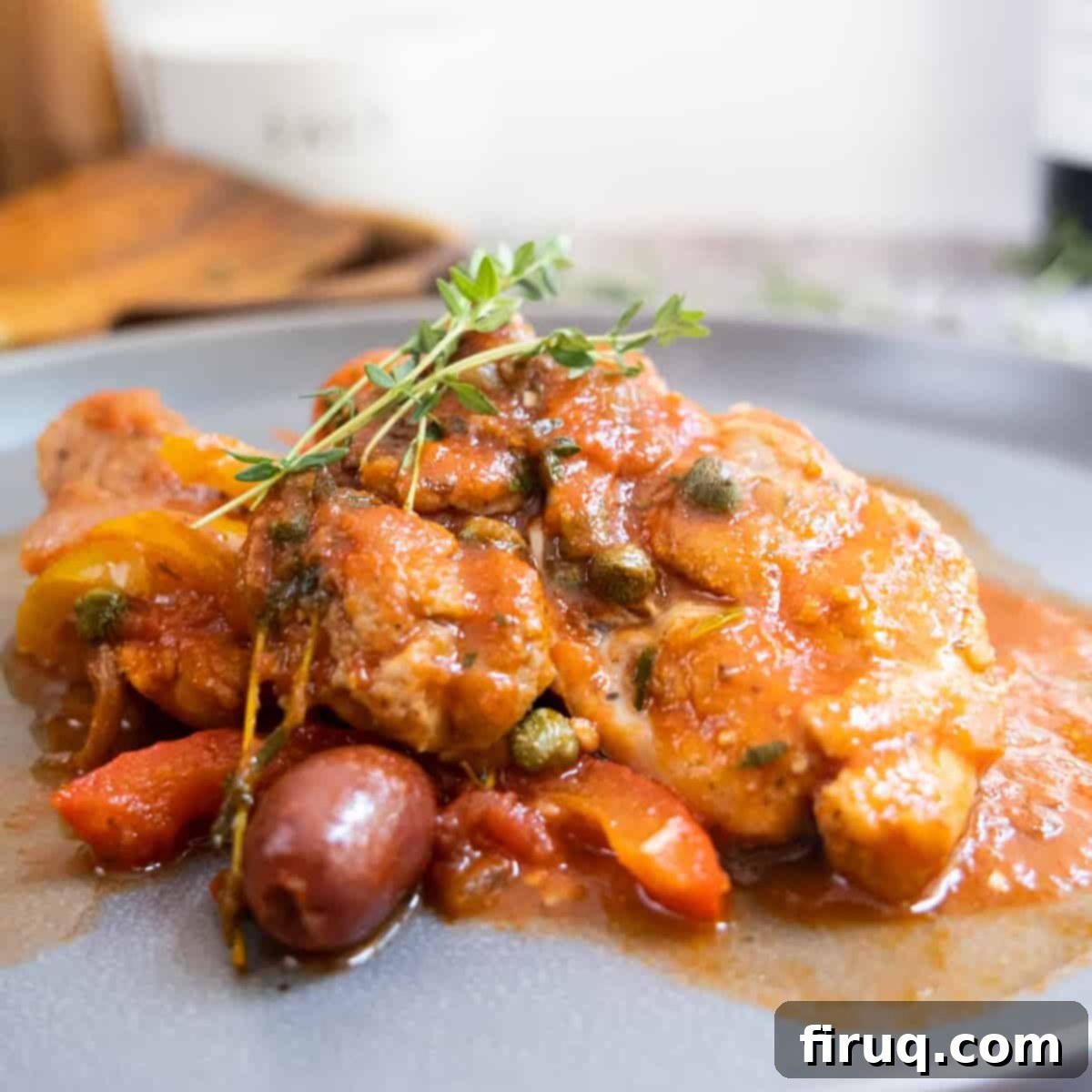Authentic & Easy Chicken Cacciatore: A Rustic Italian Family Meal for Any Night
There’s nothing quite like a heartwarming, rustic Italian dish that brings the entire family to the table, and this Easy Chicken Cacciatore recipe does exactly that. It’s a true culinary gem – simple to prepare, incredibly flavorful, and generous enough to provide delightful leftovers for the next day. This particular rendition of chicken cacciatore is exceptionally tasty, boasting a rich, savory sauce that pairs beautifully with a variety of your favorite starches, whether you prefer the comforting embrace of creamy polenta, fluffy rice, hearty pasta, or perfectly roasted potatoes.
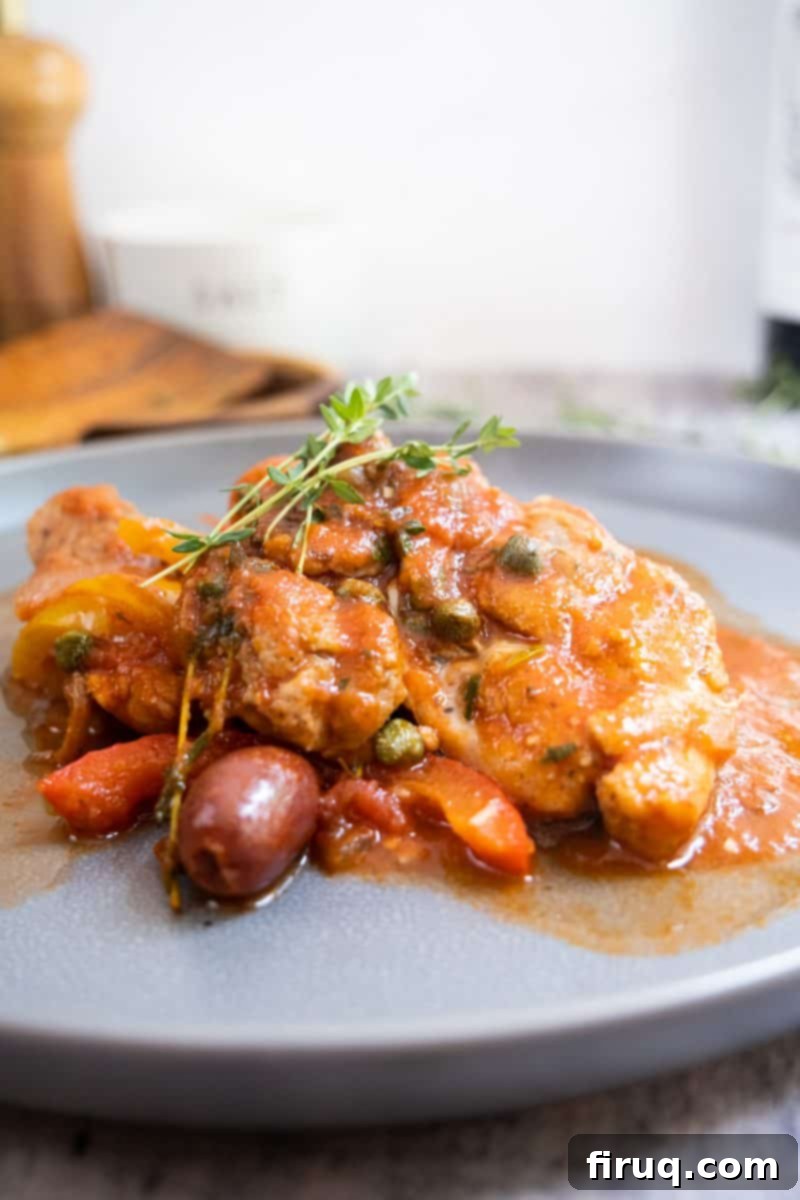
Craving more of these incredible braised recipes that make your house smell absolutely divine? You’ll love exploring our other Italian favorites like Authentic Bolognese, Authentic Italian Braciole, or our succulent Italian Short Ribs with Gnocchi.
Why Chicken Cacciatore Simplifies Mealtime
Chicken Cacciatore, meaning “hunter’s style” in Italian, is more than just a meal; it’s an experience. It’s one of those magical recipes that fills your home with an intoxicating aroma, instantly making everyone feel welcome and cozy. There’s truly nothing quite like stepping into a house permeated with the rich, fragrant scents of garlic, onions, and simmering tomatoes – a comforting fragrance that transports me straight back to my childhood. I vividly remember coming inside after playing outdoors, instantly knowing from that delicious scent that Mom was busy in the kitchen, preparing something wonderful like Authentic Italian Sunday Sauce or a hearty Classic Pasta Fagioli.
When I’m cooking for my family, my goal is always to create a complete and satisfying meal with minimal fuss. I often dread those moments when I’ve started cooking a protein and then realize I still need to figure out what vegetables to prepare and whether to make a side of pasta or rice. This is where chicken cacciatore truly shines. It’s a fantastic all-in-one meal solution, thoughtfully combining tender chicken with an abundance of vegetables, all bathed in a flavorful tomato sauce. This means you don’t have to scramble for side dishes; simply throw on a pot of pasta or rice, roast some simple potatoes, or, if you’re feeling a bit fancy, whip up some creamy mushroom truffle risotto. The sheer ease of getting this delicious, balanced meal on the table, especially with minimal cleanup thanks to the single Dutch oven, makes it a true winner in our household.
Chicken Cacciatore: Ingredient Spotlight & Smart Substitutions
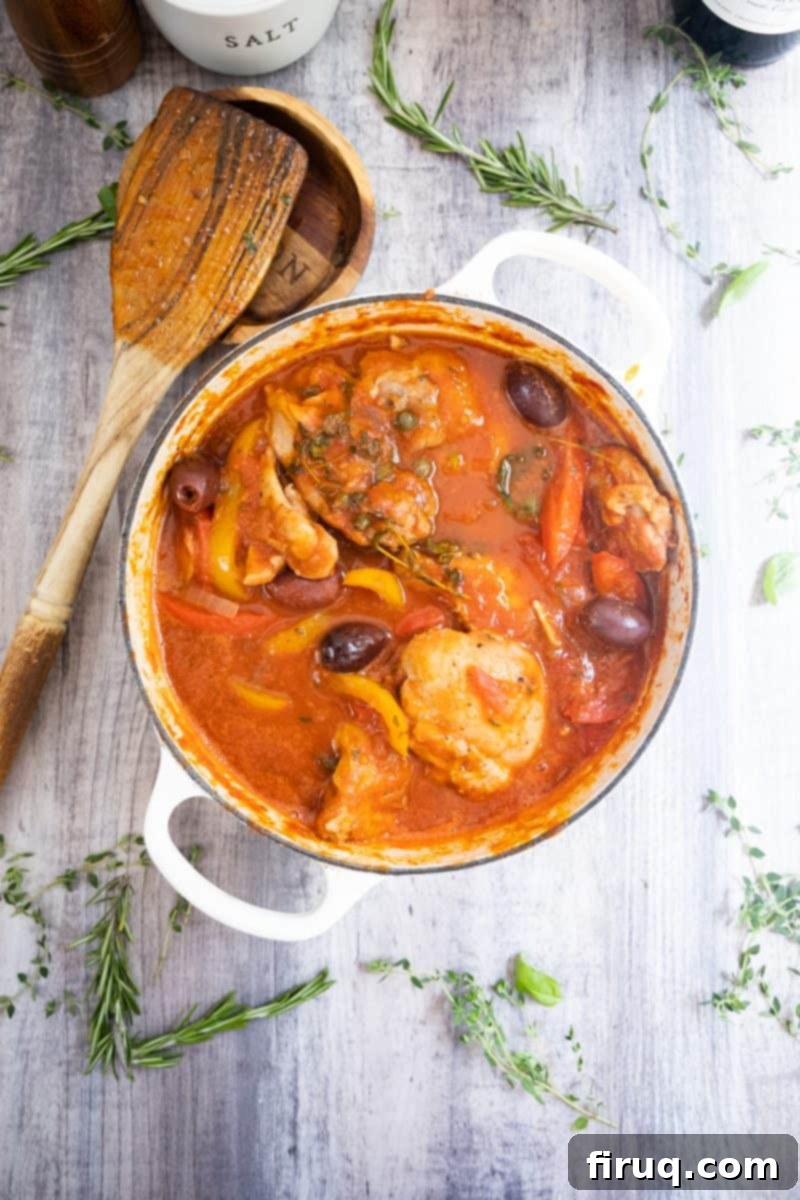
Chicken Thighs: Bone-in vs. Boneless
For this comforting cacciatore, chicken thighs are the star. You can choose either bone-in or boneless, depending on your preference and who you’re feeding. Regardless of your choice, ensure the skin is removed for this recipe. The key to incredible flavor lies in getting a really good, golden-brown sear on the chicken before braising. Bone-in chicken thighs tend to be slightly easier to sear without the risk of overcooking them entirely, as the bone helps regulate heat. With boneless thighs, you’ll need to be a little more mindful to achieve that perfect sear without cooking them all the way through initially. Boneless thighs are often favored if you have small children, as they’re easier to eat. If you’re looking for other chicken ideas, especially during grilling season, consider our Grilled Lemon Pepper Chicken Thighs, or for chicken breast, try our elegant Chicken Rollatini instead.
The Versatility of Vegetables
One of the most charming aspects of cacciatore is its adaptability when it comes to vegetables. There’s truly no single “right” recipe for cacciatore; its history is quite murky, with regional variations across Italy. While some purists might argue its origins date back to a time before tomatoes were introduced to Italy in the mid-1500s, modern cacciatore is synonymous with chicken braised in a flavorful sauce featuring tomatoes, mushrooms, and bell peppers. However, this is your kitchen, so feel free to personalize it! Add other vegetables you love or have on hand, such as carrots, celery, zucchini, or green beans, to make it truly your own and even more hearty.
Olives and Capers: Briny Bursts of Flavor
These two ingredients are powerhouses of flavor in cacciatore, adding a wonderful briny, salty, and tangy dimension that really elevates the dish. I personally love using Kalamata olives for their rich, fruity taste, but feel free to experiment with other varieties like green olives or even a mix. Capers, with their distinct piquant flavor, contribute a bright contrast to the rich tomato sauce. If either olives or capers are not to your liking, they can certainly be left out without completely compromising the integrity of the dish, though you might consider adding a squeeze of lemon juice at the end for a touch of brightness.
Red Wine: The Secret to Depth
A dry red wine is crucial for deglazing the pan and building a profound depth of flavor in your cacciatore sauce. It helps release all those caramelized bits from the bottom of the Dutch oven, which are packed with umami. If you prefer not to cook with wine, you can substitute it with an equal amount of chicken or vegetable broth. While the flavor profile will be slightly different, it will still yield a delicious result.
Fresh Herbs: Aromatic Essentials
The fragrant combination of fresh rosemary, thyme, and basil is essential for giving chicken cacciatore its signature Italian aroma and taste. Fresh herbs provide a vibrancy that dried herbs can’t quite match. If fresh herbs aren’t available, you can use dried herbs, but remember that dried herbs are more potent, so use about one-third of the amount specified for fresh, and add them earlier in the cooking process to allow their flavors to bloom.
Tomato Paste: Concentrated Flavor
Don’t underestimate the power of tomato paste! Briefly cooking it with the vegetables before adding the crushed tomatoes caramelizes its sugars, intensifying its tomato flavor and adding a crucial layer of richness and depth to the sauce. It also helps to naturally thicken the sauce as it simmers.
*For detailed measurements and further information on ingredients, please refer to the complete recipe card below.
Step-By-Step Directions for Perfect Chicken Cacciatore
This recipe is surprisingly simple to master, and once you’ve prepared your ingredients and gotten them into the pot, it practically cooks itself. The Dutch oven does most of the heavy lifting, allowing the flavors to meld beautifully as it braises.
Step 1: Sear the Chicken Thighs for Flavor
Begin by generously seasoning your chicken thighs on all sides with salt and freshly ground black pepper. In a large Dutch oven or heavy-bottomed pot, heat the olive oil over high heat until shimmering. Carefully add the chicken thighs, making sure not to overcrowd the pan (work in batches if necessary). Sear them for about 3 minutes per side, until they develop a beautiful golden-brown crust. This crucial step, known as the Maillard reaction, creates incredible depth of flavor that will permeate your entire dish.
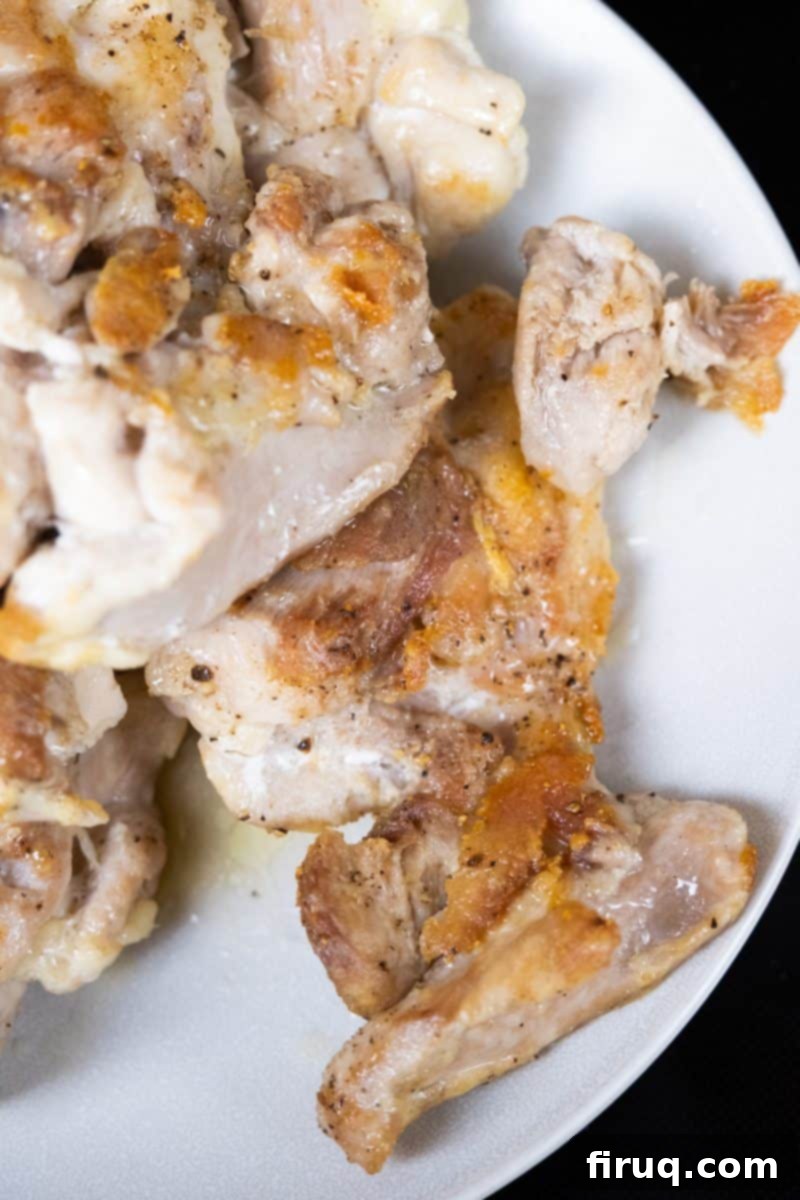
Once seared, remove the chicken thighs from the Dutch oven and set them aside on a plate. They will not be cooked through at this point, which is perfectly fine as they will finish cooking in the sauce.
Step 2: Sauté the Aromatics and Vegetables
Add a little more olive oil to the same Dutch oven, reducing the heat to medium. Add the chopped peppers and sliced mushrooms. Sauté them, stirring occasionally, until they begin to soften and release their moisture, which typically takes about 3-4 minutes. This step builds the foundational flavors of your cacciatore.
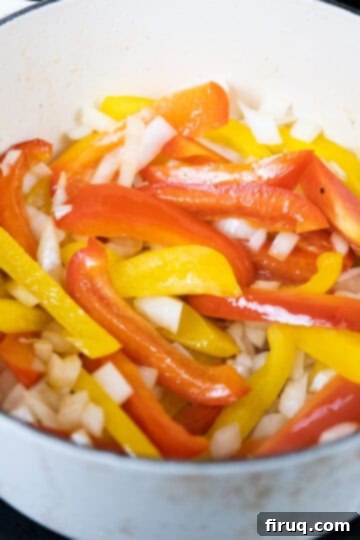
Step 3: Build the Flavor Base with Onions and Garlic
Next, add the chopped onions to the pot and continue to sauté for another 5 minutes, until they become translucent and slightly caramelized. Stir in the minced garlic and cook for just 30 seconds to 1 minute, until fragrant. Be careful not to burn the garlic, as it can turn bitter quickly.
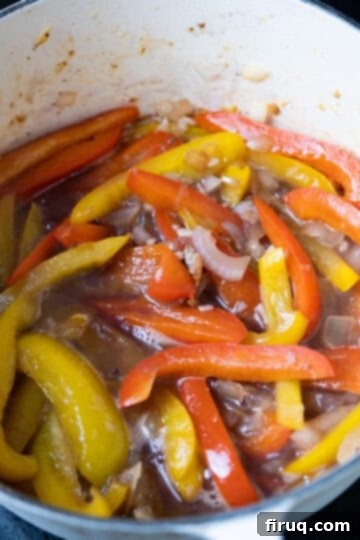
Step 4: Deglaze and Introduce Tomatoes
Stir in the tomato paste, thoroughly combining it with the sautéed vegetables. Allow the tomato paste to cook for about 2 minutes, stirring often, letting it lightly caramelize on the bottom of the pan. This step significantly deepens its flavor. Then, pour in the red wine and use a wooden spoon to vigorously scrape up all the delicious brown bits (fond) from the bottom of the pan. This fond is packed with flavor and is essential for a rich sauce.
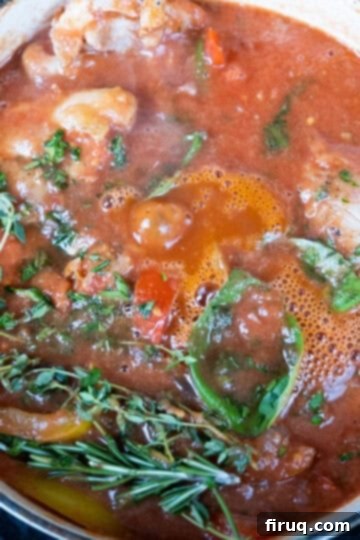
Step 5: Simmer to Perfection
Allow the red wine to simmer until it reduces by half, concentrating its rich flavor. Then, pour in the crushed tomatoes, stir well, and carefully return the seared chicken thighs to the pot, nestling them into the sauce. Add the fresh thyme, rosemary, and basil. Bring the entire sauce to a gentle simmer. Cover the Dutch oven and simmer the sauce for approximately 40 minutes, stirring occasionally to prevent the sauce from sticking and burning at the bottom. This allows the chicken to become incredibly tender and all the flavors to meld beautifully.
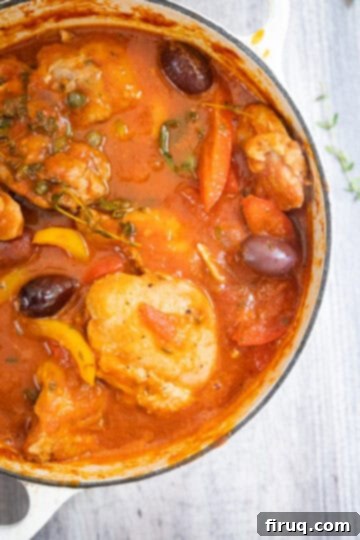
Step 6: Final Touches & Serve
After 40 minutes of simmering, add the capers and olives to the sauce. Continue to simmer for another 10 minutes to allow their flavors to integrate without becoming overly soft. Once done, remove the Dutch oven from the heat. Let it rest for a few minutes before serving with your favorite starch. Chicken cacciatore is one of those fantastic dishes that often tastes even better on day two, as the flavors have more time to deepen and harmonize. This makes it an ideal recipe for delicious leftovers!
Pro-Tips for Your Best Chicken Cacciatore
- Perfect Searing: When searing the chicken thighs, resist the urge to overcrowd the pan. I like to fill the bottom of the pan with the thighs, leaving minimal space but ensuring each piece has direct contact with the hot surface. This allows for proper browning and prevents steaming, which can make the chicken gray instead of golden. A good sear is the foundation of flavor for this dish.
- Don’t Rush the Simmer: The simmering time is not just for cooking the chicken; it’s essential for developing the rich, complex flavors of the sauce. Allow it the full time, stirring occasionally, to ensure everything melds together beautifully.
- Quality Ingredients Matter: While cacciatore is a rustic dish, using good quality ingredients, especially crushed tomatoes, can make a noticeable difference. Look for San Marzano tomatoes if possible for their sweetness and lower acidity.
- Rest Before Serving: Like many braised dishes, allowing the cacciatore to rest off the heat for 5-10 minutes before serving allows the flavors to settle and the sauce to thicken slightly.
- Make Ahead Magic: As mentioned, cacciatore often tastes even better the next day. Consider making it a day in advance to let the flavors deepen and mingle for an even more exquisite meal.
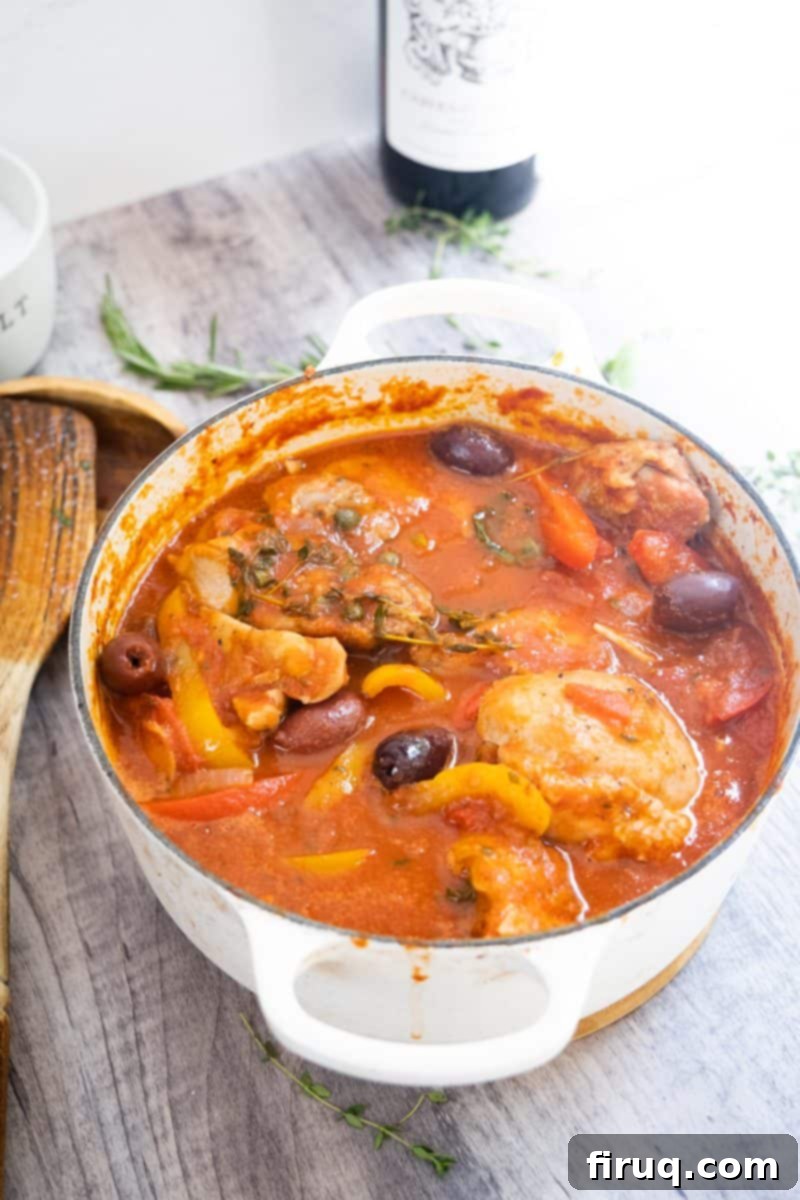
Chicken Cacciatore FAQs
Chicken cacciatore is incredibly versatile! Serve it over your favorite pasta (like tagliatelle or rigatoni), a bowl of fluffy rice, creamy polenta, or with crispy roasted potatoes. I personally love it best over rice; the grains soak up all the rich, savory flavors of the sauce beautifully, making for an incredibly filling and satisfying meal.
For the best results, I recommend reheating chicken cacciatore gently in a saucepan over medium-low heat. This allows the chicken to warm through evenly and prevents it from drying out. If you’re reheating it to serve with pasta, add a splash of pasta water or chicken broth to the pan with the cacciatore; this will help rejuvenate the sauce and ensure it clings perfectly to the pasta.
Typically, the cacciatore sauce will naturally thicken as it simmers and reduces. The tomato paste and the natural starches from the vegetables contribute to this. While you *could* add a water and cornstarch slurry, I find it’s rarely necessary. I guarantee it will thicken up beautifully once you take it off the heat and let it rest for a bit. Furthermore, it will be even thicker and more intensely flavorful on day two, making leftovers a real treat!
While chicken thighs are recommended for their juiciness and flavor, you can certainly use other cuts. Bone-in, skin-on chicken pieces (like drumsticks or a mix of thighs and drumsticks) would work wonderfully, just ensure you remove the skin before searing. Chicken breasts can also be used, but be mindful that they cook faster and can dry out more easily. If using breasts, consider cutting them into larger chunks or adding them later in the simmering process.
Traditional chicken cacciatore is not inherently spicy; it focuses on savory, tangy, and aromatic flavors. However, if you enjoy a kick, you can easily add a pinch of red pepper flakes (peperoncino) when sautéing the garlic, or include a sliced hot pepper with the bell peppers.
Absolutely! Chicken cacciatore freezes beautifully. Once cooled completely, transfer it to airtight freezer-safe containers or heavy-duty freezer bags. It can be stored in the freezer for up to 3 months. Thaw overnight in the refrigerator before reheating gently on the stovetop.
Please leave a comment and star rating below in the recipe card! I love to hear what you think of our recipes and your culinary adventures. Feel free to tag us on Instagram @vindelgiudice – we love seeing your creations!
More Classic Italian Dishes to Savor
- Restaurant-Style Chicken Marsala
- Restaurant-Style Chicken Scarpariello
- The BEST Chicken Pizzaiola
- Restaurant-Style Chicken Francese
📖 Recipe
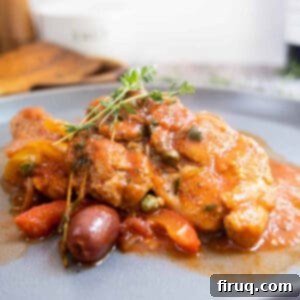
Easy Chicken Cacciatore
Vincent DelGiudice
Pin Recipe
Equipment
-
1 dutch oven
Ingredients
- 6 bone-in or boneless chicken thighs, skin removed
- 1 28 oz can crushed tomatoes
- 2 bell peppers, diced (any color)
- 1 medium onion, chopped
- 3 cloves garlic, minced
- 2 teaspoon salt, or to taste
- 8 oz mushrooms, sliced
- 2 tablespoon tomato paste
- ½ cup kalamata olives, pitted and halved
- 2 tablespoon capers, drained
- fresh rosemary, thyme, and basil, chopped (about 1 tbsp each)
- ½ cup dry red wine (or chicken broth)
- 3 tablespoon olive oil, divided
Instructions
-
Season the chicken thighs generously with salt and pepper.
-
In a large Dutch oven or heavy-bottomed pot, add 2 tablespoons of olive oil and heat over high heat. Sear the chicken thighs for 3 minutes on each side, or until golden brown. Remove the chicken and set them aside. They will not be cooked through yet.
-
Add the remaining 1 tablespoon of olive oil to the Dutch oven and lower to medium heat. Add the diced bell peppers and sliced mushrooms and sauté until they begin to soften, about 3-4 minutes. Then, add the chopped onions and sauté for another 5 minutes, until translucent. Stir in the minced garlic and cook for 30 seconds to 1 minute, until fragrant.
-
Stir in the tomato paste, combining it thoroughly with the vegetables. Allow the tomato paste to cook for 2 minutes, letting it lightly caramelize on the bottom of the pan. Pour in the red wine (or broth) and use a wooden spoon to scrape off any brown bits (fond) from the bottom of the pan. Simmer the red wine until it reduces by half. Then, pour in the crushed tomatoes and return the seared chicken to the pot. Add the chopped fresh thyme, rosemary, and basil, and bring the sauce to a gentle simmer.
-
Cover the Dutch oven and simmer the sauce for 40 minutes, stirring occasionally to prevent sticking. After 40 minutes, stir in the capers and olives and continue to simmer for another 10 minutes. Remove from the heat and let it rest for a few minutes before serving with your favorite starch! Remember, chicken cacciatore often develops an even richer flavor on day two, making it perfect for leftovers!
Notes
- When searing, avoid overcrowding the pan to ensure a beautiful golden-brown crust, which is essential for flavor development. Work in batches if necessary.
- For best results and maximum flavor, try to use high-quality crushed tomatoes.
- If you don’t consume alcohol, chicken broth or vegetable broth can be used as a substitute for red wine.
- Chicken cacciatore tastes even better the next day, making it an excellent meal prep option!
Nutrition
